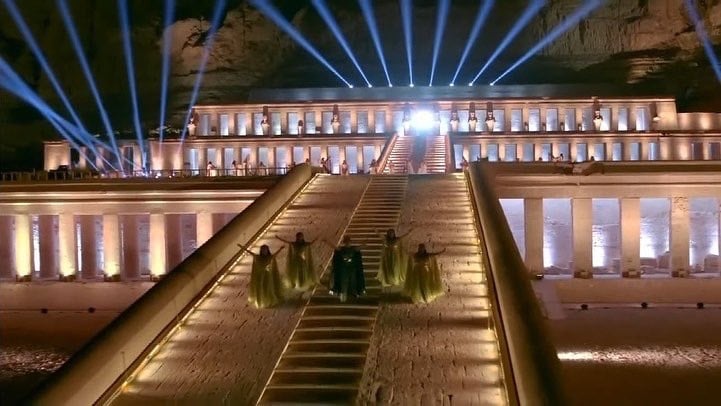
Egypt unveiled on Thursday the renovated “Avenue of the Sphinxes” with a spectacular display aimed at highlighting the country’s archaeological treasures.
The avenue at the ancient city of Thebes, now renamed Luxor, is nearly two miles long and about 250 feet wide. It dates back 3,000 years.
Also known as the Way of the Rams and the Path of the Gods it connects the famous Karnak and Luxor temples in what was Thebes, which used to be Egypt’s capital in antiquity.
A huge parade took place along the length of the avenue, which was lined on either side by over 600 ram-headed statues and traditional sphinxes, statues with a lion’s body and a human’s head.
The extravagant march included participants in pharaonic dress, a symphony orchestra, lighting effects, professional dancers, boats on the Nile, and horse-drawn carriages. Egyptian President Abdel-Fattah el-Sissi attended the city-wide spectacle.
The road was buried under sand for centuries until Egyptian archaeologist Zakaria Ghineim discovered the first eight sphinx statues in front of the Luxor Temple in 1949.
The road is believed to have been built to celebrate the annual Opet Festival in the ancient city of Thebes, now known as Luxor. The festival promoted fertility and included a procession that carried a statue of ceremonial gods from Karnak Temple to Luxor Temple.
The history of Thebes, Egypt’s ancient capital
Thebes was located along the Nile about 800 kilometers (500 miles) south of the Mediterranean.
It was the main city of the fourth Upper Egyptian nome (Sceptre nome) and was the capital of Egypt for long periods during the Middle Kingdom and New Kingdom eras. It was close to Nubia and the Eastern Desert, with its valuable mineral resources and trade routes.
Thebes was also a cult center and the most venerated city during many periods of ancient Egyptian history. The site of Thebes includes areas on both the eastern bank of the Nile, where the temples of Karnak and Luxor stand and where the city was situated; and the western bank, where a necropolis of large private and royal cemeteries and funerary complexes can be found.
In 1979, the ruins of ancient Thebes were classified by UNESCO as a World Heritage Site.
Egypt is intensifying its efforts to showcase its rich ancient past. In April, the mummies of the Egyptian pharaohs Rameses II Hatshepsut, along with twenty other pharaohs, were taken by way of a stately parade through the streets of Cairo recently so they could take up residence in their new museum, the National Museum of Egyptian Civilization (NMEC).
The new institution, at a colossal 500,000 square meters (5,381,955 square feet), is the largest museum in the world to be devoted to the portrayal of a single culture, that of the Egyptians.
See all the latest news from Greece and the world at Greekreporter.com. Contact our newsroom to report an update or send your story, photos and videos. Follow GR on Google News and subscribe here to our daily email!



